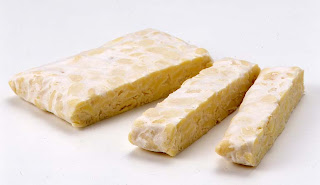Leguminous such as soybean, peanut, winged bean seeds, koro, coconut and other leguminous are source of proteins and fats and take important role in our life. Amino acid protein contained in animal protein is not as complete, the addition of other ingredients such as soybean are very good for maintaining the balance of amino acids.
Leguminous are quickly exposed by mold (aflatoxin) so easy to become withered and rotten. To overcome this problem, the materials need to be preserved or make it to a processed products.
Processed products can be food such as chips, tofu, and tempeh. Soy protein contains 35% even in the superior varieties protein content can reach 40-43%. Compared with rice, maize, cassava flour, green beans, meat, fresh fish, and eggs, soybeans have a higher protein content, nearly matching the levels of dried skim milk protein. When a person is not allowed or can not eat meat or other animal protein source, protein needs by 55 grams per day can be filled with foods derived from the 157.14 grams of soy.
Soybeans can be processed into: tempeh, tempeh crisps, tofu, soy, milk, and others.The processing of soybeans into a variety of food in general is a simple process, and equipment used enough with the tools commonly used in the household, except parer, grinding, and mold.
Soybean composition per 100 grams materials
Protein 35-45 %
Fat 18-32%
Carbohydrates 12-30%
Water 7%
Making use tempeh tempeh. Some things to note on tempeh processing in order to obtain good results.
1) Soybeans have chosen a good (not bad) and not dirty.
2) Water should be clear, odorless and contains no germs of disease.
Making use tempeh tempeh. Some things to note on tempeh processing in order to obtain good results.
1) Soybeans have chosen a good (not bad) and not dirty.
2) Water should be clear, odorless and contains no germs of disease.
3) How the process should be clean.
4) The microorganism starter must be selected that are still active.
4) The microorganism starter must be selected that are still active.
Materials
1) Soybean 10 kg
2) Yeast 20 g
3) Waters
Tools
1) large winnowing
2) basket
3) rack
4) mixer timber
5) gunny sack
6) furnace or stove
7) banana leaves or plastics
How To Make
How To Make
1) Clean the soy and then soak it overnight so the skin easily loose;
2) Peel the skin by being trampled. If there is, can use parer soybean;
3) After the peeled and washed, steamed in a steamer for 1 hour. Then chill in large winnowing tray;
4) After a cold, mixed with yeast tempeh as much as 20 grams;
5) Insert the mixture in a mold lined with plastic or wrapped in banana leaves. Leaf or plastic molds for tempeh gets air and can grow well;
6) Stack molds and cover with gunny sacks to become warm. After 1 night of mushrooms began to grow and come out hot;
7) Take these molds and place it on the shelf, lined a single layer and let stand for 1 night;
8) Remove the tempeh from the molder.





0 comments:
Posting Komentar